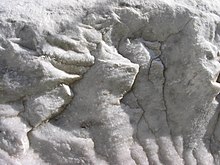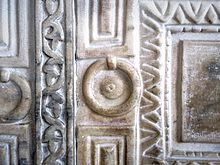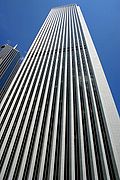Marble

Carrara marble quarry in Italy

The Taj Mahal is entirely clad in marble.
Marble is a metamorphic rock composed of recrystallized carbonate minerals, most commonly calcite or dolomite. Marble is typically not foliated, although there are exceptions. In geology, the term "marble" refers to metamorphosed limestone, but its use in stonemasonry more broadly encompasses unmetamorphosed limestone.[1] Marble is commonly used for sculpture and as a building material.
Contents
1 Etymology
2 Physical origins
3 Types
4 Uses
4.1 Sculpture
4.2 Construction marble
5 Production
5.1 Occupational safety
5.1.1 United States
6 Degradation by acids
7 Microbial degradation
8 Cultural associations
9 Artificial marble
10 Gallery
11 See also
12 References
13 External links
Etymology

Carlo Franzoni's sculptural marble chariot clock, the Car of History, depicting Clio, the Greek muse of history.

Marble wall of Ruskeala. Republic of Karelia, Russia
The word "marble" derives from the Ancient Greek μάρμαρον (mármaron),[2] from μάρμαρος (mármaros), "crystalline rock, shining stone",[3][4] perhaps from the verb μαρμαίρω (marmaírō), "to flash, sparkle, gleam";[5]R. S. P. Beekes has suggested that a "Pre-Greek origin is probable."[6]

Folded and weathered marble at General Carrera Lake, Chile
This stem is also the ancestor of the English word "marmoreal", meaning "marble-like."[citation needed] While the English term "marble" resembles the French marbre, most other European languages (with words like "marmoreal"), more closely resemble the original Ancient Greek.[citation needed]
Physical origins
Marble is a rock resulting from metamorphism of sedimentary carbonate rocks, most commonly limestone or dolomite rock. Metamorphism causes variable recrystallization of the original carbonate mineral grains. The resulting marble rock is typically composed of an interlocking mosaic of carbonate crystals. Primary sedimentary textures and structures of the original carbonate rock (protolith) have typically been modified or destroyed.
Pure white marble is the result of metamorphism of a very pure (silicate-poor) limestone or dolomite protolith. The characteristic swirls and veins of many colored marble varieties are usually due to various mineral impurities such as clay, silt, sand, iron oxides, or chert which were originally present as grains or layers in the limestone. Green coloration is often due to serpentine resulting from originally magnesium-rich limestone or dolostone with silica impurities. These various impurities have been mobilized and recrystallized by the intense pressure and heat of the metamorphism.
Types
Examples of historically notable marble varieties and locations:
| Marble | Color | Location | Country |
|---|---|---|---|
Pentelic marble[7] | pure-white, fine-grained semitranslucent | Mount Pentelicus (Πεντελικό όρος), Attica (Ἀττική) | Greece |
Creole marble | white and blue/black | Pickens County, Georgia | United States |
Etowah marble | pink, salmon, rose | Pickens County, Georgia | United States |
Makrana marble | white | Makrana, Nagaur district, Rajasthan | India |
Murphy marble | white | Pickens and Gilmer Counties, Georgia | United States |
Nero Marquina marble | black | Markina, Spain | Spain |
Parian marble | pure-white, fine-grained | Island of Paros (Πάρος), South Aegean (Νοτίου Αιγαίου) | Greece |
Carrara marble | white or blue-gray | Carrara, Tuscany | Italy |
Ruskeala marble | white | near Ruskeala (Рускеала), Karelia (Карелия) | Russia |
Rușchița marble[8] | white, pinkish, reddish | Poiana Ruscă Mountains, Caraș-Severin County | Romania |
Bianco Sivec | white | near Prilep (Прилеп), Pelagonia (Пелагониски) | Macedonia |
Swedish green marble | green | near Kolmården, Södermanland | Sweden |
Sylacauga marble | white | Talladega County, Alabama | United States |
Vermont marble | white | Proctor, Vermont | United States |
Yule marble | uniform pure white | near Marble, Colorado | United States |
Wunsiedel marble | white | Wunsiedel, Bavaria | Germany |
Uses

Ritual amphora of veined marble from Zakros. New palace period (1500–1450 BC), Heraklion Archaeological Museum, Crete.

An 1862 monumental conical pendulum clock by Eugène Farcot with a red griotte marble pedestal

Marble Products in Romblon, Philippines.
Sculpture
White marble has been prized for its use in sculptures[9] since classical times. This preference has to do with its softness, which made it easier to carve, relative isotropy and homogeneity, and a relative resistance to shattering. Also, the low index of refraction of calcite allows light to penetrate several millimeters into the stone before being scattered out, resulting in the characteristic waxy look which gives "life" to marble sculptures of any kind, which is why many sculptors preferred and still prefer marble for sculpting.
Construction marble
Construction marble is a stone which is composed of calcite, dolomite or serpentine which is capable of taking a polish.[10] More generally in construction, specifically the dimension stone trade, the term "marble" is used for any crystalline calcitic rock (and some non-calcitic rocks) useful as building stone. For example, Tennessee marble is really a dense granular fossiliferous gray to pink to maroon Ordovician limestone, that geologists call the Holston Formation.
Ashgabat, the capital city of Turkmenistan, was recorded in the 2013 Guinness Book of Records as having the world's highest concentration of white marble buildings.[11]
Production
According to the United States Geological Survey, U.S. domestic marble production in 2006 was 46,400 tons valued at about $18.1 million, compared to 72,300 tons valued at $18.9 million in 2005. Crushed marble production (for aggregate and industrial uses) in 2006 was 11.8 million tons valued at $116 million, of which 6.5 million tons was finely ground calcium carbonate and the rest was construction aggregate. For comparison, 2005 crushed marble production was 7.76 million tons valued at $58.7 million, of which 4.8 million tons was finely ground calcium carbonate and the rest was construction aggregate. U.S. dimension marble demand is about 1.3 million tons. The DSAN World Demand for (finished) Marble Index has shown a growth of 12% annually for the 2000–2006 period, compared to 10.5% annually for the 2000–2005 period. The largest dimension marble application is tile.
In 1998, marble production was dominated by 4 countries that accounted for almost half of world production of marble and decorative stone. Italy and China were the world leaders, each representing 16% of world production, while Spain and India produced 9% and 8%, respectively. Italy is the world leader in marble export, with 20% share in global marble production, followed by China with 16%, India with 10%, Spain with 6%, and Portugal with 5%.[12]
Occupational safety
Dust produced by cutting marble could cause lung disease but more research needs to be carried out on whether dust filters and other safety products reduce this risk.[13]
United States
The Occupational Safety and Health Administration (OSHA) has set the legal limit (permissible exposure limit) for marble exposure in the workplace as 15 mg/m3 total exposure and 5 mg/m3 respiratory exposure over an 8-hour workday. The National Institute for Occupational Safety and Health (NIOSH) has set a recommended exposure limit (REL) of 10 mg/m3 total exposure and 5 mg/m3 respiratory exposure over an 8-hour workday.[14]
Degradation by acids
Acids damage marble, because the calcium carbonate in marble reacts with them, releasing carbon dioxide (technically speaking, carbonic acid, but that disintegrates quickly to CO2 and H2O) :
- CaCO3(s) + 2H+(aq) → Ca2+(aq) + CO2(g) + H2O (l)
Thus, vinegar or other acidic solutions should never be used on marble. Likewise, outdoor marble statues or other marble structures are damaged by acid rain.
Microbial degradation
The haloalkaliphilic methylotrophic bacterium Methylophaga murata was isolated from deteriorating marble in the Kremlin.[15] Bacterial and fungal degradation was detected in four samples of marble from Milan cathedral; black Cladosporium attacked dried acrylic resin[16] using melanin.[17]
Cultural associations

Jadwiga of Poland's sarcophagus by Antoni Madeyski, Wawel Cathedral, Cracow

Relief on the Marble Door of the Hagia Sophia in Istanbul
As the favorite medium for Greek and Roman sculptors and architects (see classical sculpture), marble has become a cultural symbol of tradition and refined taste. Its extremely varied and colorful patterns make it a favorite decorative material, and it is often imitated in background patterns for computer displays, etc.
Places named after the stone include Marblehead, Massachusetts; Marblehead, Ohio; Marble Arch, London; the Sea of Marmara; India's Marble Rocks; and the towns of Marble, Minnesota; Marble, Colorado; Marble Falls, Texas, and Marble Hill, Manhattan, New York. The Elgin Marbles are marble sculptures from the Parthenon in Athens that are on display in the British Museum. They were brought to Britain by the Earl of Elgin.
Artificial marble
Marble dust is combined with cement or synthetic resins to make reconstituted or cultured marble. The appearance of marble can be simulated with faux marbling, a painting technique that imitates the stone's color patterns.
Gallery
.mw-parser-output .mod-gallery{display:table}.mw-parser-output .mod-gallery-default{background:transparent;margin-top:0.5em}.mw-parser-output .mod-gallery-center{margin-left:auto;margin-right:auto}.mw-parser-output .mod-gallery-left{float:left}.mw-parser-output .mod-gallery-right{float:right}.mw-parser-output .mod-gallery-none{float:none}.mw-parser-output .mod-gallery-collapsible{width:100%}.mw-parser-output .mod-gallery .title{display:table-row}.mw-parser-output .mod-gallery .title>div{display:table-cell;text-align:center;font-weight:bold}.mw-parser-output .mod-gallery .main{display:table-row}.mw-parser-output .mod-gallery .main>div{display:table-cell}.mw-parser-output .mod-gallery .caption{display:table-row;vertical-align:top}.mw-parser-output .mod-gallery .caption>div{display:table-cell;display:block;font-size:94%;padding:0}.mw-parser-output .mod-gallery .footer{display:table-row}.mw-parser-output .mod-gallery .footer>div{display:table-cell;text-align:right;font-size:80%;line-height:1em}.mw-parser-output .mod-gallery .gallerybox .thumb img{background:none}.mw-parser-output .mod-gallery .bordered-images img{border:solid #eee 1px}

The Nike of Samothrace is made of Parian marble (c. 220–190 BC)

Laocoön and His Sons in the Vatican
The Praetorians Relief, made from grey veined marble, c. 51–52 AD

Ancient marble columns in the prayer hall of the Mosque of Uqba, in Kairouan, Tunisia

Aon Center in Chicago was the tallest structure clad in marble upon its completion. The marble however proved to be fragile, and the building was re-clad in a similarly-colored granite at an extreme financial cost.

Cleopatra by William Wetmore Story was described and admired in Nathaniel Hawthorne's romance, The Marble Faun, and is on display at The Metropolitan Museum of Art in New York City

As with many Brazil's government buildings in Brasília, the Palácio do Planalto, official workplace of the Brazilian President, is clad in marble
See also
- Marble sculpture
- Paper marbling
Pietra dura, inlaying with marble and other stones
Scagliola, imitating marble with plasterwork
Verd antique, sometimes (erroneously) called "serpentine marble"
Ruin marble, marble that contains light and dark patterns, giving the impression of a ruined cityscape
References
^ Kearey, Philip (2001). Dictionary of Geology, Penguin Group, London and New York, p. 163. .mw-parser-output cite.citation{font-style:inherit}.mw-parser-output q{quotes:"""""""'""'"}.mw-parser-output code.cs1-code{color:inherit;background:inherit;border:inherit;padding:inherit}.mw-parser-output .cs1-lock-free a{background:url("//upload.wikimedia.org/wikipedia/commons/thumb/6/65/Lock-green.svg/9px-Lock-green.svg.png")no-repeat;background-position:right .1em center}.mw-parser-output .cs1-lock-limited a,.mw-parser-output .cs1-lock-registration a{background:url("//upload.wikimedia.org/wikipedia/commons/thumb/d/d6/Lock-gray-alt-2.svg/9px-Lock-gray-alt-2.svg.png")no-repeat;background-position:right .1em center}.mw-parser-output .cs1-lock-subscription a{background:url("//upload.wikimedia.org/wikipedia/commons/thumb/a/aa/Lock-red-alt-2.svg/9px-Lock-red-alt-2.svg.png")no-repeat;background-position:right .1em center}.mw-parser-output .cs1-subscription,.mw-parser-output .cs1-registration{color:#555}.mw-parser-output .cs1-subscription span,.mw-parser-output .cs1-registration span{border-bottom:1px dotted;cursor:help}.mw-parser-output .cs1-hidden-error{display:none;font-size:100%}.mw-parser-output .cs1-visible-error{font-size:100%}.mw-parser-output .cs1-subscription,.mw-parser-output .cs1-registration,.mw-parser-output .cs1-format{font-size:95%}.mw-parser-output .cs1-kern-left,.mw-parser-output .cs1-kern-wl-left{padding-left:0.2em}.mw-parser-output .cs1-kern-right,.mw-parser-output .cs1-kern-wl-right{padding-right:0.2em}
ISBN 978-0-14-051494-0
^ μάρμαρον, Henry George Liddell, Robert Scott, A Greek–English Lexicon, on Perseus Digital Library
^ μάρμαρος, Henry George Liddell, Robert Scott, A Greek–English Lexicon, on Perseus Digital Library
^ Marble, Compact Oxford English Dictionary. Askoxford.com. Retrieved on 2011-09-30.
^ μαρμαίρω, Henry George Liddell, Robert Scott, A Greek-English Lexicon, on Perseus Digital Library
^ R. S. P. Beekes, Etymological Dictionary of Greek, Brill, 2009, p. 907.
^ Pentelic marble, Britannica Online Encyclopaedia. Britannica.com. Retrieved on 2011-09-30.
^ "RAPORT DE ȚARĂ. Domul din Milano a fost reconstruit cu marmură de Rușchița".
^ PROCEEDINGS 4th International Congress on “Science and Technology for the Safeguard of Cultural Heritage in the Mediterranean Basin” VOL. I. Angelo Ferrari. ISBN 9788896680315.
^ Marble Institute of America pp. 223 Glossary
^ "Turkmenistan enters record books for having the most white marble buildings | World news". London: theguardian.com. 2013-05-26. Retrieved 2013-11-24.
^ Strategic positioning study of the marble branch. CEPI Brief N° 6. tunisianindustry.nat.tn
^ Foja, A.F. (1993) Marble industry: its socioeconomic, environmental and health effects among marble worker/producer households in Romblon. Philippines University Thesis. fao.org
^ "CDC – NIOSH Pocket Guide to Chemical Hazards – Marble". www.cdc.gov. Retrieved 2015-11-27.
^ Doronina NV; Li TsD; Ivanova EG; Trotsenko IuA. (2005). "Methylophaga murata sp. nov.: a haloalkaliphilic aerobic methylotroph from deteriorating marble". Mikrobiologiia. 74 (4): 511–9. PMID 16211855.
^ Cappitelli F; Principi P; Pedrazzani R; Toniolo L; Sorlini C (2007). "Bacterial and fungal deterioration of the Milan Cathedral marble treated with protective synthetic resins". Science of the Total Environment. 385 (1–3): 172–81. doi:10.1016/j.scitotenv.2007.06.022. PMID 17658586.
^ Cappitelli F; Nosanchuk JD; Casadevall A; Toniolo L; Brusetti L; Florio S,; Principi P; Borin S; Sorlini C (Jan 2007). "Synthetic consolidants attacked by melanin-producing fungi: case study of the biodeterioration of Milan (Italy) cathedral marble treated with acrylics". Applied and Environmental Microbiology. 73 (1): 271–7. doi:10.1128/AEM.02220-06. PMC 1797126. PMID 17071788.
External links
| Wikimedia Commons has media related to Marble. |
Dimension Stone Statistics and Information – United States Geological Survey minerals information for dimension stone- USGS 2005 Minerals Yearbook: Stone, Crushed
- USGS 2005 Minerals Yearbook: Stone, Dimension
- USGS 2006 Minerals Yearbook: Stone, Crushed
- USGS 2006 Minerals Yearbook: Stone, Dimension
- Marble Institute of America






